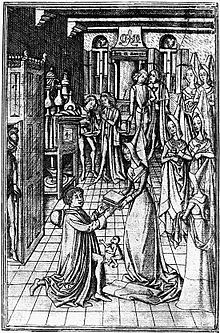The Duchess and The Printer
William Caxton offering the first book ever printed in English to his patron Margaret of York
This year marks the 550th anniversary of the first-ever printed book in English. A worthy topic for a writer's blog, I think!
Last night, I spoke at my Book Club who, having just read The Personal Librarian, chose to read my Daughter of York, when I explained that William Caxton (the "printer" of my blog title) was a major character in it. Thus the members could enjoy the connection between J.P. Morgan's obsession to obtain a certain Caxton-printed book for his NY library and how that book came to be.
The"duchess" of my title is, if you hadn't guessed, Margaret of York, the protagonist in my second book. It was a longer book than the usual choice of our club, but not as long as the Stephen King one of a few months ago, which I confess I did not get through. (In my old age, I have only minimum patience for books I have no interest in reading--even for a book club. I know, I know, "That's what a book club is all about," you protest, but sorry, supernatural, fantasy and dystopian fiction just ain't my cuppa Darjeeling: I like my stories plausible and based in reality. Some people might think that's boring, but I find dragons, magic, aliens, and zombies boring. I sometimes wonder if I have an underdeveloped imagination!)
Back to Caxton and Margaret! How were they connected? Caxton was cloth merchant from Kent who had settled in Bruges, becoming a member of the Merchant Adventurers, another name for what was termed "The English Nation" or ex-pat merchant Brits living in Bruges. He rose to be their Governor, and as such, he was presented to the new Duchess of Burgundy, Margaret of York, who was married to Charles the Bold with extraordinary pageantry in Bruges in 1468. (That wedding was so much fun to write, because we have minute details of what transpired in those few days of celebration.)
Margaret was a bibliophile (ok, she loved books!) as was Caxton, and pretty soon they struck up a friendship, which ended up by Caxton accepting Margaret's invitation to give up merchant adventuring and join her household. Caxton had been working on translating into English from the French Les Recuyelles de la Histoire de Troy. It was also a favorite of Margaret's and she asked him to show her what pages he had completed He admitted he'd had little leisure time to work on it and that his French wasn't perfect. Margaret corrected a few phrases and was impressed enough to decide he should finish it under her auspices.
Finish it he did, with an introduction that included a dedication to the duchess: "meekly beseeching the bounteous Highness of my said Lady Margaret that of her benevolence she might accept this simple and rude work here following..."
Not satisfied with a merely translation of the book into English, Margaret was determined to see it printed in English. To that end, she funded Caxton's journey to Cologne study the new art of letterpress invented by Gutenburg some 20 years before. There, in 1473 Caxton was able to produce The Recuyell of the Histories of Troye, which became the first-ever book printed in English.
Caxton went on from strength to strength, first setting up in Bruges and ending up in Westminster with a recommendation from Margaret to her brother Edward IV, who, with other members of the English court, gave the successful printer several commissions at his print shop 'The Sign of the Red Pale.'
We book lovers have much for which to be grateful to Margaret of York! She was, of course, the sister of King Richard III, and here I can plug a Goodreads (US-only, I am afraid) Giveaway of 50 of the e-book version of my most recent, This Son of York, my take on Richard III's story.Sign up, if you're on Goodreads--you may be lucky!




Comments